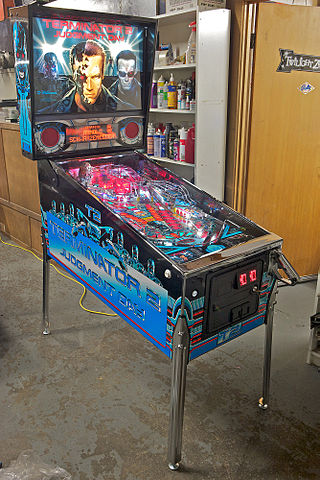
Pinball games are a family of games in which a ball is propelled into a specially designed table where it bounces off various obstacles, scoring points either en route or when it comes to rest. Historically the board was studded with nails called 'pins' and had hollows or pockets which scored points if the ball came to rest in them. Today, pinball is most commonly an arcade game in which the ball is fired into a specially designed cabinet known as a pinball machine, hitting various lights, bumpers, ramps, and other targets depending on its design. The game's object is generally to score as many points as possible by hitting these targets and making various shots with flippers before the ball is lost. Most pinball machines use one ball per turn, and the game ends when the ball(s) from the last turn are lost. The biggest pinball machine manufacturers historically include Bally Manufacturing, Gottlieb, Williams Electronics and Stern Pinball.
A glossary of terms, commonly used in discussing pinball machines.

Medieval Madness is a Williams pinball machine released in June 1997. Designed by Brian Eddy and programmed by Lyman Sheats, it had a production run of 4,016 units. As of April 3, 2022, the Pinside pinball community lists it as the #2 highest-ranked pinball machine ; many adherents consider it the greatest of all time.
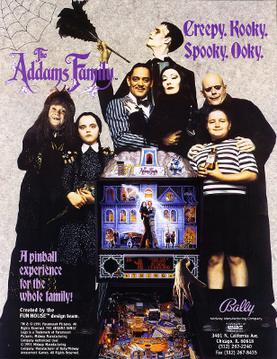
The Addams Family is a pinball machine released in March 1992. It was designed by Pat Lawlor and Larry DeMar and released by Midway. It was based on the 1991 film of the same name, and features custom speech by the stars of the film, Anjelica Huston and Raul Julia. It is the best-selling solid state pinball machine of all time with 20,270 units sold.
Patrick M. Lawlor is a video game and pinball machine designer.
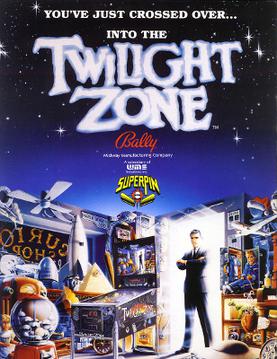
Twilight Zone is a widebody pinball machine, designed by Pat Lawlor and based on the TV series of the same name. It was first released in 1993 by Midway. This game is part of WMS' SuperPin line of widebody games alongside Star Trek: The Next Generation and Indiana Jones: The Pinball Adventure.

Cirqus Voltaire is a 1997 pinball game, designed by John Popadiuk and released by Williams Electronics Games. The theme involves the player performing many different marvels in order to join the circus. Some of the game's distinctive features include a neon light running along the right-hand ramp, a pop bumper that rises up from the middle of the playfield at certain times, and a magnet at the top of the left ramp that can catch balls and divert them into the locks. The most notable feature is the Ringmaster, a head that rises at certain times and taunts the player.

The Getaway: High Speed II is a 1992 pinball game by Steve Ritchie. It is a sequel to 1986's High Speed.
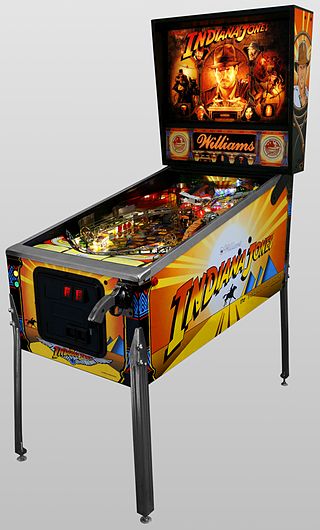
Indiana Jones: The Pinball Adventure is a 1993 widebody pinball game designed by Mark Ritchie and released by Williams. It was based on the Indiana Jones movies. It was also part of WMS' SuperPin series of widebody games.
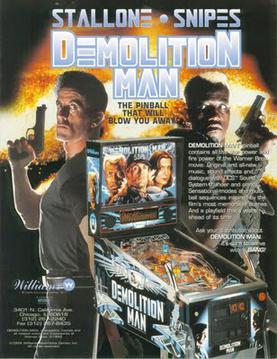
Demolition Man is a Williams pinball machine released in February 1994. It is based on the motion picture of the same name. It is part of WMS' SuperPin line of widebody games.

The Flintstones is a pinball game released by Williams in 1994 and based on the movie of the same name which is based on 1960–1966 animated television series of the same name. This machine is not to be confused with another pinball machine, a redemption game, based on the TV series and also released in 1994, manufactured by Innovative Concepts in Entertainment (ICE).
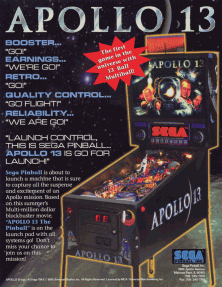
Apollo 13 is a 1995 pinball machine based on the film Apollo 13. It was designed by Joe Kaminkow and Joe Balcer, and released by Sega Pinball. It is notable for its 13-ball multiball mode, the largest of any pinball machine ever made.

Checkpoint is a 1991 pinball machine released by Data East. It featured the first dot matrix display (DMD) ever incorporated into a pinball game. For Checkpoint, Data East used a "half-height" DMD. By way of comparison, Williams later produced machines with standard DMDs that were twice the height. Checkpoint also features video mode minigames on its display.
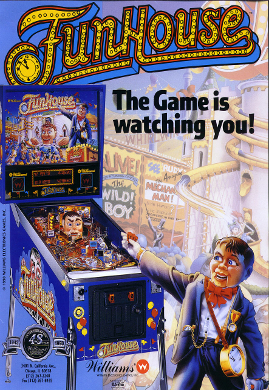
FunHouse is a pinball machine designed by Pat Lawlor and released in November 1990 by Williams Electronics. Starring a talking ventriloquist dummy named Rudy, the game is themed after the concept of an amusement park funhouse. FunHouse is one of the last Williams games to use an alphanumeric display; the company switched to dot matrix the following year.

The Who's Tommy Pinball Wizard is a pinball machine based on the rock musical The Who's Tommy. The machine features twenty-one songs from the musical sung by original Broadway cast members. The game was designed by Joe Kaminkow, Ed Cebula, Lonnie D. Ropp, and Lyman F. Sheats Jr. The machine was built using Solid-state electronics type components. The backbox of the machine has a dot matrix display with animations by Kurt Andersen and Markus Rothkranz. 4,700 machines were manufactured by Data East in January 1994.

The Party Zone is a crossover solid-state pinball machine released in 1991 by Midway designed by Dennis Nordman and programmed by Jim Strompolis. It is in a single playfield format and collaborates characters from previous pinball machines. It is the second pinball machine released after the Bally-Midway division was sold, yet still operated under the "Bally" name.

Judge Dredd is a four-player pinball game produced by Bally Manufacturing in 1993, based on the British comic strip Judge Dredd in 2000 AD. Nearly 7,000 were made.

The Champion Pub is a pinball game released by Williams Electronics Games in 1998. The theme of the game revolves around boxing in a 1920s pub.
Time Warp is a 4 player Solid State Electronic pinball machine from September 1979 produced by Williams. A total of 8,875 units were produced.
The Hobbit is a pinball machine designed by Joe Balcer and released by Jersey Jack Pinball in March 2016. It is based on The Hobbit films of the same name which is based on J. R. R. Tolkien’s 1937 novel The Hobbit.
















